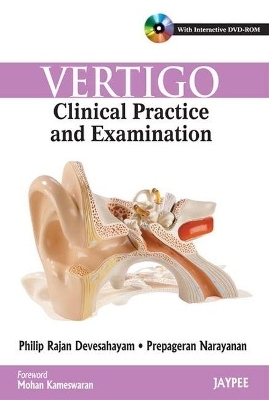
Vertigo: Clinical Practice and Examination
Jaypee Brothers Medical Publishers
978-93-5025-895-8 (ISBN)
Vertigo is the feeling that everything around is moving or spinning and is usually caused by a problem with the balance mechanisms in the inner ear. It can also be caused by problems in certain parts of the brain or vision disorders.
This concise handbook is a quick reference introducing the key concepts of vertigo. Beginning with an explanation of the key terms and the causes of dizziness, the following chapters discuss the examination, diagnosis and management of vestibular (parts of the inner ear and brain that process the sensory information involved with controlling balance and eye movements) disorders.
An ancillary DVD of 27 videos demonstrates clinical neuro-otologic examination techniques and clinical findings.
Key Features
Concise introduction to key concepts of vertigo
Explains key terms, causes, examination, diagnosis and management
Includes DVD demonstrating clinical examination techniques and findings
Philip Rajan Devesahayam MBBS (Malaya) MMed ORL-HNS (USM) Consultant Otolaryngologist, Department of Otorhinolaryngology, Hospital Raja Permaisuri Bainun, Ipoh, Perak, Malaysia Prepageran Narayanan MBBS (Malaya) MS ORL (UM) FRCS (Ed) FRCS (Glas) Professor, Senior Consultant and Head Otolaryngologist, Department of Otorhinolaryngology, University Malaya Medical Center, Kuala Lumpur, Malaysia
Key Terms
Causes of Dizziness
Vestibular System
Features of a Vestibular Disorder
Peripheral Vestibular Disorders
Central Vestibular Disorders
Vertigo or Dizziness in Special Circumstances
Examination
Investigations
DVD Contents
Clinical Examination
Otoscopy
Tuning Fork Tests
Spontaneous Nystagmus
Oculomotor Tests
Halmagyi Manoeuvre
Head Shake Test
VOR Suppression
Oscillopsia
Romberg’s and Gait
Cerebellar Tests
Left Modified Epley’s (Canalith Re-positioning Procedure)
Clinical Findings
Otoscopic Findings
Congenital Nystagmus
Spontaneous Nystagmus—Horizontal (Peripheral Vestibular Lesion)
Spontaneous Nystagmus—Vertical (Central Nervous System Disorder)
Gaze-Evoked Nystagmus—Horizontal (Central Nervous System Disorder)
Gaze-Evoked Nystagmus—Vertical (Central Nervous System Disorder)
Smooth Pursuit Deficit (Central Nervous System Disorder)
Positive Halmagyi (Peripheral Vestibular Lesion)
Positive Head Shake Test (Peripheral Vestibular Lesion)
Positive Oscillopsia Test (Bilateral Vestibular Loss)
Oscillopsia (As the Patient Sees it)
Cerebellar Gait (Central Nervous Sys-tem Disorder)
Cerebellar Ataxia (Central Nervous System Disorder)
Dix-Hallpike Maneuver (with Frenzel’s Glasses)
Positive Dix-Hallpike Maneuver (Posterior Canal BPPV)
Positive Eye Cover Test (Central Nervous System Disorder)
| Erscheint lt. Verlag | 30.12.2012 |
|---|---|
| Zusatzinfo | 24 Halftones, color; 30 Illustrations |
| Verlagsort | New Delhi |
| Sprache | englisch |
| Maße | 159 x 241 mm |
| Gewicht | 150 g |
| Themenwelt | Medizin / Pharmazie ► Medizinische Fachgebiete ► HNO-Heilkunde |
| ISBN-10 | 93-5025-895-1 / 9350258951 |
| ISBN-13 | 978-93-5025-895-8 / 9789350258958 |
| Zustand | Neuware |
| Haben Sie eine Frage zum Produkt? |